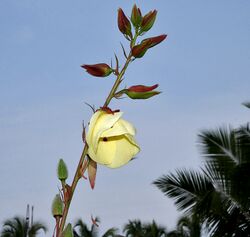Biology:Abelmoschus manihot
| Abelmoschus manihot | |
|---|---|

| |
| Scientific classification | |
| Kingdom: | Plantae |
| Clade: | Tracheophytes |
| Clade: | Angiosperms |
| Clade: | Eudicots |
| Clade: | Rosids |
| Order: | Malvales |
| Family: | Malvaceae |
| Genus: | Abelmoschus |
| Species: | A. manihot
|
| Binomial name | |
| Abelmoschus manihot (L.) Medik
| |
| Synonyms[1] | |
|
List
| |
Abelmoschus manihot, commonly known as aibika, is a flowering plant in the family Malvaceae. It was previously classified as a species of Hibiscus but is now categorized under the genus Abelmoschus. This plant is also referred to as the sunset muskmallow, sunset hibiscus, or hibiscus manihot.
Growth Habit
Although technically a shrub, aibika is a perennial plant that, under favorable conditions, can grow over three meters in height. It is easily propagated through cuttings and relatively disease-resistant. As a result, it is widely cultivated and often found along garden borders or as an intercrop in traditional tropical gardens. Its growth habit, along with its nutritional value, contributes to its popularity in home gardening and horticulture.[2]
Nutrition
Aibika is renowned for its highly nutritious properties. Its leaves are rich in essential vitamins, including a high content of vitamins A and C, as well as iron. Moreover, they contain approximately 12% protein by dry weight, making aibika a valuable dietary source. The leaves are commonly incorporated into various dishes such as tinola, sinigang, pinangat, or used in salads in regions like the Philippines .[3]
Applications
Apart from its culinary uses, aibika has additional applications in different cultures. In Japan , it is known as tororo aoi and is utilized to produce neri, a starchy substance used in traditional Japanese papermaking (washi). Similarly, in Korean, it is referred to as hwang chok kyu and plays a role in making dak pul, an ingredient used in the production of hanji, Korean paper.[citation needed]
Chemical constituents
A chromatographic and spectroscopic analysis published in China Journal of Chinese Materia Medica revealed the presence of thirteen compounds in aibika. These compounds include myricetin, cannabiscitrin, myricetin-3-O-beta-D-glucopyranoside, glycerolmonopalmitate, 2, 4-dihydroxy benzoic acid, guanosine, adenosine, maleic acid, heptatriacontanoic acid, 1-triacontanol, tetracosane, β-Sitosterol, and beta-sitosterol-3-O-beta-D-glucoside.[4]
References
- ↑ "Abelmoschus manihot (L.) Medik.". Board of Trustees of the Royal Botanic Gardens, Kew. 2017. http://powo.science.kew.org/taxon/urn:lsid:ipni.org:names:558020-1#synonyms.
- ↑ Thaman, R.R. Rural Fiji. Institute of Pacific Studies, University of the South Pacific 1988, p. 41.
- ↑ Maghirang, Rodel G. (14 January 2017). "Lagikway, The Perennial Shrub". Agriculture Monthly. https://www.agriculture.com.ph/2017/01/14/lagikway-the-perrenial-shrub/.
- ↑ Lai, X. Y.; Zhao, Y. Y.; Liang, H. (2006). "Studies on chemical constituents in flower of Abelmoschus manihot". China Journal of Chinese Materia Medica 31 (19): 1597–1600. PMID 17165583.
External links
- Abelmoschus manihot (L.) Medic. Medicinal Plant Images Database (School of Chinese Medicine, Hong Kong Baptist University) (in Chinese) (in English)
Wikidata ☰ Q749221 entry
 |


